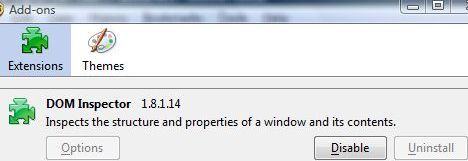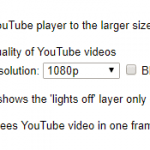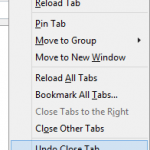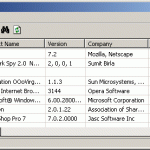In Mozilla Firefox web browser, sometimes an extension, toolbar (which is installed as add-on), theme or other add-on cannot be uninstalled or removed through the use of the Firefox Add-ons window. The “Uninstall” button on the Add-ons window appears to be disabled or grayed out. In such cases, try the following workarounds to manually force uninstall, remove or delete the ‘stubborn’ add-ons, themes, toolbars, or extensions.
Workaround 1: Uninstall using program’s uninstaller or from Windows Add or Remove Programs
Some add-ons or extensions is installed by their respective application programs, and can be, or need to be uninstalled through the respective setup installer/uninstaller. Typically, uninstallation of program can be done through “Add or Remove Programs” (in Windows XP) or “Uninstall a program” (for Windows Vista, Windows 7 and Windows 8) or “Apps and Features” (in Windows 10) in Control Panel or Settings of Windows. Remember to exit from Firefox before start the uninstallation process.
Workaround 2: Uninstall from Firefox Safe Mode
If the extension, toolbar, theme or other addon does not provide any uninstaller, and uninstall button is grayed out, try to uninstall the add-on in Safe Mode.
To access Safe Mode, close all Firefox windows.
In Windows, click Start, open the All Programs list, and navigate to the Mozilla Firefox folder. In the Mozilla Firefox folder, select Mozilla Firefox (Safe Mode). Alternatively, type in Run box or Start Search box (for Windows Vista, Windows 7, Windows and Windows 10) the following command:
firefox -safe-mode
In Mac OS X, hold down the Option key when starting Firefox to run it in Safe Mode. Alternatively, go to the Utilities directory (in the Applications folder) and open Terminal, then run the following command:
/path/to/firefox/firefox -safe-mode
For example,
/Applications/Firefox.app/Contents/MacOS/firefox -safe-mode
Firefox should start up with a Firefox Safe Mode dialog. With Firefox in safe mode, some extensions and add-ons Uninstall button in Add-ons window, which previously disabled, is now enabled for proper uninstallation.
Workaround 3: Uninstall manually user-specific extensions, toolbars, themes and add-ons
If all methods fail to remove or uninstall an extensions, user can manually uninstall an add-on using steps below, which work for user-centric add-ons:
- Open the Firefox profiles folder, which normally located at %AppData%\Mozilla\Firefox\Profiles\xxxxxxxx.default\, where xxxxxx is a random string and .default is the name of the profile. User should pick the profile folder (if inside Profiles folder there are multiple sub-folders) that are active, i.e. profile for user account to uninstall the extension.
- Open the extensions folder inside the profile folder.
- Each folder here inside the “extensions” folder corresponds to an extension. Some folders may have readable name that resembles the plugin, extension or toolbar, and can be easily recognized. Often the names of the folders are obscured. To identify which extension or plug-in the folder is representing, go to each folder and perform the following steps:
- Use a text editor (e.g. Notepad or alternative text editor) to open the install.rdf file inside it.
- Search for the following text:
em:name - Locate the folder with install.rdf file with the name after the “em:name” corresponding to the extension intends to remove or delete.
- Delete the whole folder for the extension.
Workaround 4: Manually uninstall globally installed extensions
Some most ‘stubborn’ extensions that persistently don’t allow user to uninstall via Firefox Add-ons window is installed globally. To remove a globally installed extension follow these steps:
- Go to Firefox installation folder, typically C:\Program Files\Mozilla Firefox.
- Go to the extensions folder inside the installation folder.
- Each folder here inside the “extensions” folder corresponds to an extension. Some folders may have readable name that resembles the plugin, extension or toolbar, and can be easily recognized. Often the names of the folders are obscured. To identify which extension or plug-in the folder is representing, go to each folder and perform the following steps:
- Use a text editor (e.g. Notepad or alternative text editor) to open the install.rdf file inside it.
- Search for the following text:
em:name - Locate the folder with install.rdf file with the name after the “em:name” corresponding to the extension intends to remove or delete.
- Delete the whole folder for the extension.







